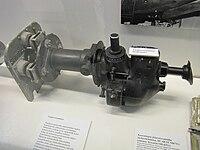Drift meter

A drift meter is like a very fancy compass that helps planes and boats know how fast and which direction they are moving in.
Imagine you are playing a game where you have to walk in a straight line blindfolded. It's not easy, right? Now imagine you have a friend watching you walk and telling you if you're going to the left or right. This makes it a little easier to stay on the right path.
That's kind of what a drift meter does, but for things that move in water or air. It tells the pilot or captain if they are drifting to the left or right, which helps keep everything on track.
It works by using special sensors that measure changes in the Earth's magnetic field to figure out which direction the plane or boat is heading. Then, it compares it to the direction that it should be heading, based on the wind or water currents.
If the plane or boat is actually moving in a slightly different direction than it should be, the drift meter tells the pilot or captain how much they need to adjust their course to stay on track.
Overall, a drift meter is an important tool for both safety and efficiency, helping make sure that planes and boats reach their destination safely and on time.
Imagine you are playing a game where you have to walk in a straight line blindfolded. It's not easy, right? Now imagine you have a friend watching you walk and telling you if you're going to the left or right. This makes it a little easier to stay on the right path.
That's kind of what a drift meter does, but for things that move in water or air. It tells the pilot or captain if they are drifting to the left or right, which helps keep everything on track.
It works by using special sensors that measure changes in the Earth's magnetic field to figure out which direction the plane or boat is heading. Then, it compares it to the direction that it should be heading, based on the wind or water currents.
If the plane or boat is actually moving in a slightly different direction than it should be, the drift meter tells the pilot or captain how much they need to adjust their course to stay on track.
Overall, a drift meter is an important tool for both safety and efficiency, helping make sure that planes and boats reach their destination safely and on time.
Related topics others have asked about:
